Information about my research

Radio Astronomy Image Gallery

Meet the Molecules of C/1996 B2 Hyakutake
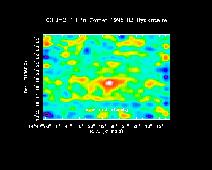
This image shows, in false color, the emission from carbon monoxide molecules
in Comet C/1996 B2 Hyakutake shortly before it passed the Earth. The emission
shows up as reddish/white here. The image was made on 21 March 1996, with
the NRAO 12m radiotelescope atop Kitt Peak, Arizona, by Jeff Mangum using
the newly implemented `on-the-fly' mapping technique. The spectral line
here is very narrow, but emission has been integrated over all velocity
channels to construct this image. The nominal telescope beam is 30" at
1.3mm wavelength, but the image was convolved to 40" resolution to improve
the signal to noise ratio. As a comet warms on its journey around the sun,
molecules boil off of the icy nucleus. CO boils off particularly far from
the sun, when the nuclear temperature is only about 20 K, and powers activity
in the comet's coma far from the sun. As the comet approaches the sun, the
evaporation of other molecules powers increasingly violent activity. Three
days after this image was taken, emission from ammonia
molecules was detected with the NRAO 43m telescope in Green Bank, West
Virginia. The ammonia emission suggested that the temperature of the gas
near the nucleus was 67 K at that time, sufficiently warm for many molecules
to leave the nucleus.

Destruction of a molecular cloud.

This image shows, in red, the emission from carbon monoxide molecules
in a gas cloud in Ophiuchus called R12. The image was made with the NRAO
12m radiotelescope in September, 1995 using the newly implemented `on-the-fly'
mapping technique. The spectral line here is very narrow, but emission has
been integrated over all velocity channels to construct this image. The hot
B star rho Ophiuchi is located to the southeast, and its ionizing radiation
is penetrating the cloud, heating the dust, which in turn heats the gas.
Additionally, the ultraviolet radiation is destroying the CO molecules.
In blue, we see the IRAS image at 100 microns, showing the cooler dust.
In green, the IRAS image at 12 microns is displayed, showing the warmer dust
on the eastern edge of R12. The offset of the hot dust toward the star clearly
shows that in the eastern and southern boundary regions, all CO molecules
have been destroyed already, but the dust remains. This work is in collaboration
with Jeff Mangum (Submillimeter Telescope Observatory, University of Arizona)
and Bill Latter (NASA
Ames Research Center).
Formation of a young star.
 Earlier on
another page was shown the striking molecular flow emanating from the very
young source VLA1623. This image shows a spatially smaller flow powered
by a somewhat more luminous source in the dark cloud L1157. This image was
obtained in September 1995 at the NRAO 12m telescope, using the newly implemented
`on-the-fly' imaging mode. The dense clump of material at the protostar
is not shown in this view, but it lies between the lobe of redshifted CO
molecules (shown, naturally, in red) and the lobe of blueshifted gas (in
blue). The ambient gas in the surrounding cloud is shown in green. In August
1995, powerful redshifted emission from water molecules was detected at the
position of the protostar for the first time with the NRAO 43m telescope.
An image of the water maser was soon made with the NRAO Very Large Array,
which showed that the emission arose within a few dozen astronomical units
of the protostar itself, indicating that the forces which power the flow
are set in motion close to the central object. Presumably, matter is still
falling onto the protostar from the ambient cloud through a flattened, disklike
structure. As the star struggles to achieve hydrostatic equilibrium, matter
and energy are expelled from the poles, resulting in the flow illustrated
here. This work is in collaboration with Mark Claussen (NRAO) and Bruce
Wilking (University of Missouri at St. Louis).
Earlier on
another page was shown the striking molecular flow emanating from the very
young source VLA1623. This image shows a spatially smaller flow powered
by a somewhat more luminous source in the dark cloud L1157. This image was
obtained in September 1995 at the NRAO 12m telescope, using the newly implemented
`on-the-fly' imaging mode. The dense clump of material at the protostar
is not shown in this view, but it lies between the lobe of redshifted CO
molecules (shown, naturally, in red) and the lobe of blueshifted gas (in
blue). The ambient gas in the surrounding cloud is shown in green. In August
1995, powerful redshifted emission from water molecules was detected at the
position of the protostar for the first time with the NRAO 43m telescope.
An image of the water maser was soon made with the NRAO Very Large Array,
which showed that the emission arose within a few dozen astronomical units
of the protostar itself, indicating that the forces which power the flow
are set in motion close to the central object. Presumably, matter is still
falling onto the protostar from the ambient cloud through a flattened, disklike
structure. As the star struggles to achieve hydrostatic equilibrium, matter
and energy are expelled from the poles, resulting in the flow illustrated
here. This work is in collaboration with Mark Claussen (NRAO) and Bruce
Wilking (University of Missouri at St. Louis).
Optical and radio views of a dark molecular cloud.
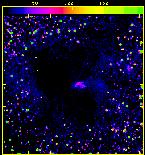 In the
infrared image (in the `J' band at 1.2 microns) in the this panel, the dark
cloud L483 stands out against a Scutum starfield. Deep within, a purple
glow locates one lobe of a flow emanating from the densest part of the cloud,
completely hidden from view at even the longest infrared wavelengths accessible
from the Earth's surface. At these wavelengths, we could never peer into
the cloud and uncover the mechanisms of star formation. Radio techniques
remedy this situation. Image courtesy of Gary Fuller.
In the
infrared image (in the `J' band at 1.2 microns) in the this panel, the dark
cloud L483 stands out against a Scutum starfield. Deep within, a purple
glow locates one lobe of a flow emanating from the densest part of the cloud,
completely hidden from view at even the longest infrared wavelengths accessible
from the Earth's surface. At these wavelengths, we could never peer into
the cloud and uncover the mechanisms of star formation. Radio techniques
remedy this situation. Image courtesy of Gary Fuller.
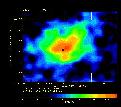 The bottom
panel shows an image of C18O J=1-->0 emission taken by the NRAO 12m radiotelescope.
Here the interstellar gas glows with emission from the carbon monoxide molecules,
which, mixed with dust, completely obscured the star-forming interior of
the cloud in the previous image. Note how the gas glows most brightly where
accretion onto a protostar warms the cloud. Only a dozen or so objects in
the sky are thought to be as young as this protostar, which appears to be
growing into a young star of about the same mass as the Sun. At this stage
in its evolution, however, most of the matter which will eventually be incorporated
into the star and its planets still lies in the surrounding cloud. Thus
the L483 protostar offers us a chance to understand how interstellar gas
and dust clouds form stars and planets.
The bottom
panel shows an image of C18O J=1-->0 emission taken by the NRAO 12m radiotelescope.
Here the interstellar gas glows with emission from the carbon monoxide molecules,
which, mixed with dust, completely obscured the star-forming interior of
the cloud in the previous image. Note how the gas glows most brightly where
accretion onto a protostar warms the cloud. Only a dozen or so objects in
the sky are thought to be as young as this protostar, which appears to be
growing into a young star of about the same mass as the Sun. At this stage
in its evolution, however, most of the matter which will eventually be incorporated
into the star and its planets still lies in the surrounding cloud. Thus
the L483 protostar offers us a chance to understand how interstellar gas
and dust clouds form stars and planets.
Optical and radio views of a dark molecular cloud.
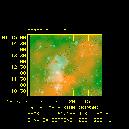 In some
molecular clouds, whole clusters of stars form. In this cloud in Serpens,
there are at least 50 young stars; three stars are thought to be in their
`protostellar' stage. In blue tones, we see an infrared image taken at a
wavelength of 2.2 microns by Casali, Eiroa and Duncan. In red tones, we
see an image of emission from formaldehyde molecules at 72 GHz, taken with
the NRAO 12m radiotelescope. Note that the stars, visible in the infrared
image, avoid the gas and dust cloud, which glows red in this false color
image, obscuring background objects. Deep within the clump at bottom center
lies a protostar known as Serpens Submillimeter Source 4, or SMM4. Thus
named owing to its brilliance at wavelengths shorter than one millimeter,
it does not appear striking in this image. The very dense dust associated
with a new star emits a continuous spectrum which increases rapidly in brightness
at shorter wavelengths, and submillimeter maps have provided a useful tool
for locating the youngest stars. In an image made at the Caltech Submillimeter
Observatory, in the light of much warmer formaldehyde gas, SMM4 is pinpointed
by the hot gas warmed by the nascent star. In this image, however, made
in the light of cold formaldehyde gas at 4.5 mm wavelength, the location
of the star is not easily noted. At the upper right, a short linear feature
locates a second, quite luminous, young star called SMM1. A bipolar flow
can be seen driving outward from this star in images made in the light of
the carbon monoxide molecule, similar to what is seen in L1157 or VLA1623
images elsewhere on this page. Just to the north of it lies an enigmatic
double object, called S68N or SMM9 which may be the youngest of the young
stars in the image. It is the subject of intense current investigation.
In some
molecular clouds, whole clusters of stars form. In this cloud in Serpens,
there are at least 50 young stars; three stars are thought to be in their
`protostellar' stage. In blue tones, we see an infrared image taken at a
wavelength of 2.2 microns by Casali, Eiroa and Duncan. In red tones, we
see an image of emission from formaldehyde molecules at 72 GHz, taken with
the NRAO 12m radiotelescope. Note that the stars, visible in the infrared
image, avoid the gas and dust cloud, which glows red in this false color
image, obscuring background objects. Deep within the clump at bottom center
lies a protostar known as Serpens Submillimeter Source 4, or SMM4. Thus
named owing to its brilliance at wavelengths shorter than one millimeter,
it does not appear striking in this image. The very dense dust associated
with a new star emits a continuous spectrum which increases rapidly in brightness
at shorter wavelengths, and submillimeter maps have provided a useful tool
for locating the youngest stars. In an image made at the Caltech Submillimeter
Observatory, in the light of much warmer formaldehyde gas, SMM4 is pinpointed
by the hot gas warmed by the nascent star. In this image, however, made
in the light of cold formaldehyde gas at 4.5 mm wavelength, the location
of the star is not easily noted. At the upper right, a short linear feature
locates a second, quite luminous, young star called SMM1. A bipolar flow
can be seen driving outward from this star in images made in the light of
the carbon monoxide molecule, similar to what is seen in L1157 or VLA1623
images elsewhere on this page. Just to the north of it lies an enigmatic
double object, called S68N or SMM9 which may be the youngest of the young
stars in the image. It is the subject of intense current investigation.

Molecules escape a dying star, carrying new atoms into space.
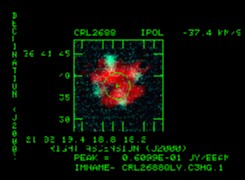 False color
image of molecular emission around the star AFGL2688, the Egg Nebula, from
VLA and optical telescope data. The HC3N J=5->4 emission (45.5 GHz) is
in red, in a velocity slice at line center, so that we see the distribution
in the plane of the sky for this expanding envelope, as if we were to slice
an onion and examine one of its layers. Superimposed, in a southwestern
turquoise, is the 2 micron H2 image which NRAO Jansky Fellow Bill Latter
published last year. Molecular hydrogen requires high temperatures for its
excitation, probably provided here by shocks in a fast wind emanating from
the poles of the star. The H2 is four-lobed, with the brightest lobe in
the north, where the pole is tipped toward us slightly; the lobe lies just
beyond the brightest knot of HC3N J=5-4 emission. There is a second lobe
symmetrically placed in the south, lying just beyond the southern HC3N emission.
There are also east and west H2 knots, though there is apparently no HC3N
near those points--cyanoacetylene is produced from photodissociation byproducts
of parent molecules, including HCN, and apparently photodissociating light
does not penetrate into the equator of the system far enough for much HC3N
to be produced, though excitation might have something to do with the way
we see the emission. The UV does penetrate in the (thinner?) polar direction,
so we see a broken ring of emission at 3" radius from the star. The ring
in IRC+10216 would lie at a radius of 1" at the 1 kpc (?) distance of the
Egg, but the mass loss rate in the Egg is about an order of magnitude higher
than in IRC. For many more stunning pictures of gracefully aging stars, see
Bill Latter's home
page.
False color
image of molecular emission around the star AFGL2688, the Egg Nebula, from
VLA and optical telescope data. The HC3N J=5->4 emission (45.5 GHz) is
in red, in a velocity slice at line center, so that we see the distribution
in the plane of the sky for this expanding envelope, as if we were to slice
an onion and examine one of its layers. Superimposed, in a southwestern
turquoise, is the 2 micron H2 image which NRAO Jansky Fellow Bill Latter
published last year. Molecular hydrogen requires high temperatures for its
excitation, probably provided here by shocks in a fast wind emanating from
the poles of the star. The H2 is four-lobed, with the brightest lobe in
the north, where the pole is tipped toward us slightly; the lobe lies just
beyond the brightest knot of HC3N J=5-4 emission. There is a second lobe
symmetrically placed in the south, lying just beyond the southern HC3N emission.
There are also east and west H2 knots, though there is apparently no HC3N
near those points--cyanoacetylene is produced from photodissociation byproducts
of parent molecules, including HCN, and apparently photodissociating light
does not penetrate into the equator of the system far enough for much HC3N
to be produced, though excitation might have something to do with the way
we see the emission. The UV does penetrate in the (thinner?) polar direction,
so we see a broken ring of emission at 3" radius from the star. The ring
in IRC+10216 would lie at a radius of 1" at the 1 kpc (?) distance of the
Egg, but the mass loss rate in the Egg is about an order of magnitude higher
than in IRC. For many more stunning pictures of gracefully aging stars, see
Bill Latter's home
page.
Further study is under way. Authors: Al Wootten, Bill Latter , Truong-Bach,
and Nguyen-Q-Rieu.

Back to myHome Page












